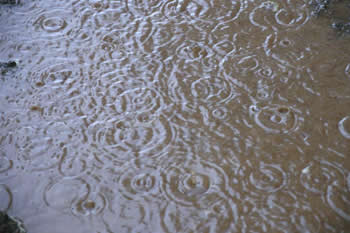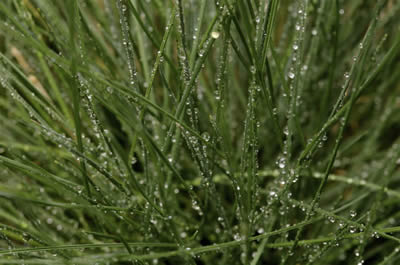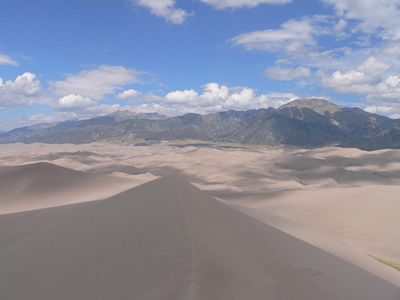Urban areas can help make clouds and rain fall within or downwind of the city.
Click on image for full size
Courtesy of the University Corporation for Atmospheric Research
Weather in Urban Areas
Heavy rainfall often occurs around cities. In fact, cities themselves can affect the weather. Scientists have several different hypotheses that may explain how cities impact rain.
One hypothesis is that the urban heat island effect, which causes warmer temperatures in cities, creates unstable air which leads to rain. Air is unstable when it is warmer than the air around it. The warm, unstable air starts to rise. The air cools as it rises, which allows water vapor within it to condense and form clouds. If the warm, rising air was carrying enough water vapor, those clouds can grow into rainclouds.
Another hypothesis is that when wind hits the skyscrapers and other tall buildings in a city, it is pushed up higher in the atmosphere. This makes unstable air. The unstable air flows upward and cools, allowing water vapor to condense, forming clouds, which can lead to rain.
Tall buildings might have another effect that causes clouds and rain. As wind approaches the buildings, it may be divided with some of it blowing around one side of the city and some of it blowing around the other side. Past the city, the wind comes back together. It collides, flows upward, cools, and releases water vapor forming clouds.
Air pollution in cities may also affect cloud formation and rain. Water vapor condenses on tiny particles in the air pollution, forming the droplets that make a cloud.
Last modified July 15, 2009 by Lisa Gardiner.
You might also be interested in:

Rain is precipitation that falls to the Earth in drops of 5mm or more in diameter according to the US National Weather Service. Virga is rain that evaporates before reaching the ground. Raindrops form
...more
The air in urban areas can be 2 - 5°C (3.6 - 9°F) warmer than nearby rural areas. This is known as the urban heat island effect. It’s most noticeable when there is little wind. An urban heat island can
...more
Condensation is the process by which water changes its state from a vapor or gas to a liquid. Condensation is responsible for the formation of clouds. Common examples of condensation are: dew forming on
...more
Wind is moving air. Warm air rises, and cool air comes in to take its place. This movement creates different pressures in the atmosphere which creates the winds around the globe. Since the Earth spins,
...more
A cloud is composed of tiny water droplets or ice crystals that are suspended in the air. A series of processes have to happen in order for these water droplets or ice crystals to form into clouds in the
...more
What do smog, acid rain, carbon monoxide, fossil fuel exhausts, and tropospheric ozone have in common? They are all examples of air pollution. Air pollution is not new. As far back as the 13 th century,
...more
When you look up at the sky, you are looking at more than just air. There are also billions of tiny bits of solid and liquid floating in the atmosphere. Those tiny floating particles are called aerosols
...more















